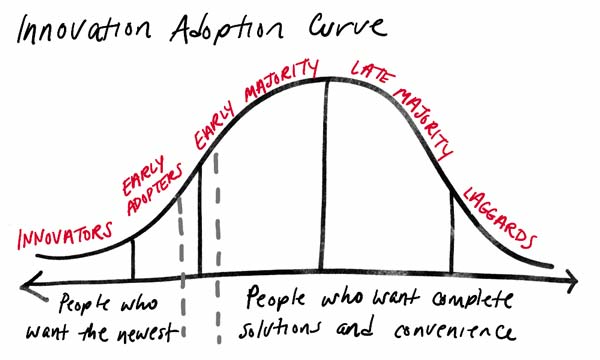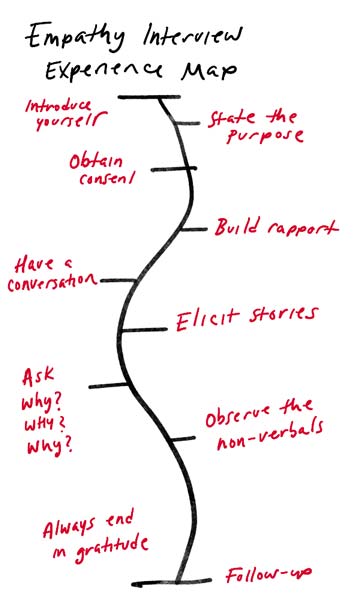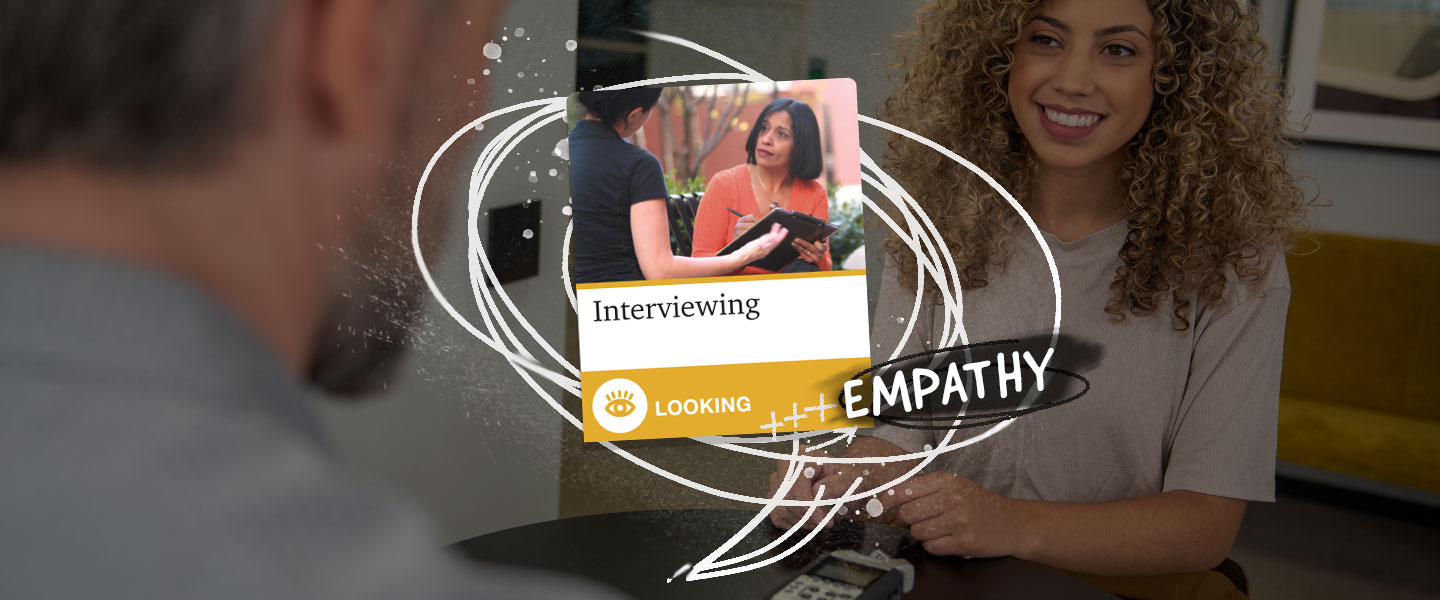Conducting great interviews is the secret sauce to finding surprising insights and new discoveries that can lead to the best outcomes. In my work as a human-centered design professional, I’ve conducted dozens of interviews and guided my clients through running their own interviews and site visits (contextual inquiries). Along the way, I’ve uncovered some facilitation tips I’d like to share with our friends in the LUMA Community. Note: These tips apply to on-site or remote interviews!
The power of Interviewing
At the core of human-centered design (HCD) is empathy: the most successful HCD outcomes are achieved when designers take the time to build empathy for the people they are serving. While there are many design methods and techniques that can help us to build empathy, one of the most effective is Interviewing – or what we refer to more specifically as Empathy Interviewing.
Empathy Interviewing goes deeper than a typical interview you might see on the news. It allows the interviewer to have an authentic and candid conversation with a stakeholder to learn from their personal experiences. Learning first-hand from key stakeholders allows us to build a greater understanding of the perspectives, motivations, and emotions of the people we are seeking to serve.
Ultimately, this leads to solutions that are more innovative and address latent needs you can’t capture with quantitative research alone. Quantitative research shows you the what, while qualitative research goes deeper and gives you the whys behind the what.
Let’s have a look at the steps it takes to prepare, conduct, and document a great and effective Empathy Interview.
Preparing for the interview
First, you’ll want to meet with your team and align on what you want to learn from the interviews. If you’re a team of one, reserve plenty of time to reflect on your own about your goals. After all, this is the reason why we conduct research: to learn something new and address gaps in our knowledge.
I suggest making a list of knowledge gaps first. Even if you have some existing knowledge about a given subject matter, you’ll want to set up your interview to learn entirely from the perspectives of the people you’re talking with. They are, in fact, the experts who will broaden your current perspective and inform your project – if you’re open to this type of discovery.
Once you’ve identified the knowledge gaps and what you’d like to learn, you can create an interview protocol; this will serve as a guide for your conversations with interviewees. Remember, this protocol is only an outline. It’s absolutely okay if the interview moves more fluidly or if you miss a few questions. Interviewing can take some improvisation!
At minimum, your protocol should contain the following components to prepare you to conduct a successful interview:
- A personal introduction
- A conversation guide
- A gracious conclusion
Let’s break each of those down:
A personal introduction
When beginning your interview, obtain consent from your participant, introduce yourself, and share the purpose of the conversation. Try to get to know the interviewee on a more personal level: people will share more when they feel comfortable with someone and have established a level of trust. Share a bit of background information about you and your team and how you’ll use their input to inform your work.
A conversation guide
Include a list of at least 8-10 questions you’d like to ask based on the knowledge gaps you’ve identified. At LUMA, we coach our practitioners to focus on three types of questions:
- Simple, conversational questions that allow you to build rapport with your interviewee.
- Storytelling questions that encourage the participant to share anecdotes. Stories help humans connect to one another and they help researchers gain empathy for the experiences of others. Actively listening to these stories can uncover key insights related to a person’s emotions, behaviors, beliefs, and values. These questions are usually prefaced with “Can you tell me more about that….?” You can also ask “Show me…?” questions to encourage interviewees to tell a story with a visual reference.
- Open-ended questions can reveal new learnings and insights you may not have previously considered. Here you want to be as curious as an excited child learning about the world asking, “Why, why, why?”
Asking “Why?” digs deeper into motivations behind someone’s perspective, helps you to better understand someone’s behaviors, and can identify unmet needs. There are several ways to ask “Why?” without sounding too repetitive. Here are some options…- Why did you say/think/do that?
- Can you share why that made you feel that way?
- Really? Why was that?
- Tell me more about why…
Be sure to avoid asking leading questions. For instance, “You must have felt really upset about that situation, didn’t you?” Instead you might ask, “How did that make you feel?”
While guiding the discussion, you should spend about 80 percent of your time listening and 20 percent (or less) asking primary and follow-up questions, always keeping the spotlight on the interviewee.
A gracious conclusion
Gratitude goes a long way. Thank the interviewee for their time and ask if you can follow up with them if you have any additional questions.
Bonus tip: LUMA Workplace® has a great Interview Protocol Template to get you started on creating a well-structured interview.
Selecting interviewees
I recommend starting with five to seven people from a broad, diverse range of perspectives. After talking to more than five people, you may start to hear similar stories, and at this point you may decide that you’ve gathered enough data to inform this phase of your project. Each person’s experience is unique and there is always something new to learn. If your research can benefit from hearing more stories, continue your interviews until you have acquired a sufficient amount of insights to take action.
You’ll want to include people close to your topic, those who don’t know anything about your topic, and those who fall somewhere in-between. This will help to reduce the risk of confirmation bias: talking only to people who think similarly. For instance, if you’re a product manager for a healthcare service provider tasked with improving online resources for members, you’ll want to talk to people who are frequent users of the current resources, those who are unaware of those resources, and others who may only use the resources sparingly. That way you’ll have gained perspectives from broader points of view.
Another way to include broader perspectives is to consider talking to people that fall along the Rogers Innovation Adoption Curve. Developed by Bohlen, Beal, and Rogers at Iowa State University in 1957, this theory classifies adopters of innovations into five categories shown in my diagram below. Fun fact: it was originally applied to agriculture and home economics, but later applied to new ideas and technologies by Everett Rogers in his book, Diffusion of Innovations.

Select people who fall into the early and late majorities, as well as the extremes on each end of the spectrum including innovators, early adopters, and laggards. Learning from extremes can lead to surprising insights that encourage solutions that go beyond the obvious, common knowledge.
Conducting the interview
After you’ve spent time planning, you’re finally ready to conduct the interviews! Select an environment that is natural and comfortable for the people you’re interviewing. If you’re talking in-person, this might include their office, home, or preferred café or restaurant. When interviewing in their space, you have the bonus opportunity to make additional observations and you may be able to ask them to show you some visual references. Pay close attention to any non-verbal cues. If you’re conducting the interview remotely, ask if they have a preferred platform to maximize their comfort.
It’s best practice and wise to bring along some help. If you can, invite at least one other researcher to come with you: one person can focus on facilitating the interview and the other person can document and observe. It’s very important for the interviewer to be fully present and engaged in the conversation. Be sure to record a copious amount of notes, or get their consent to record the interview and transcribe it later!
Resist the natural human urge to interpret what’s being shared during the interview. Instead, focus on the interviewee and document the experiences and perspectives they’re sharing. You’ll take time to interpret the findings after the conversation.
After the interview: transcribing your findings
After the interview, you’ll want to spend time debriefing with your team (or on your own if you’re the only interviewer.) During the debrief, the goal is to extract the new learnings and insights you set out to discover. Revisit your interview protocol and share and exchange notes from each of your team members.
One framework I’ve used with research teams is called POEMS, which stands for People, Objects, Environment, Messaging, and Services. This ethnographic framework – which was developed by Kumar and Whitney at IIT Institute of Design – has proven valuable in documenting key learnings from interviews and especially useful in aligning interviews across multiple researchers. POEMS provides a systematic way to code your interview notes and observations as you capture them. This makes post-interview analysis much more efficient. Learn more about the POEMS framework.
Another way to gather insights and identify new learnings from an interview is to use the tried-and-true design method Rose, Thorn, Bud. Apply Rose, Thorn, Bud to your interview notes as a way to codify the data. This will help you to transcribe your notes into clear categories, identifying the positives, negatives, and potentials from each of the interviews conducted. Next, you can Affinity Cluster your data to look for patterns and summarize what you’ve learned. This is incredibly valuable whether you’re an individual researcher or working with a team.
A summary of my tips for conducting an effective Empathy Interview:

- Build rapport with your interviewee.
- Check your assumptions at the door and approach every conversation with an open mind.
- Be like a curious child and ask “Why?” often.
- Have a map (protocol) for your conversation, but don’t be afraid to wonder to discover new things.
- You have two ears and one mouth: listen 80 percent of the time and speak 20 percent of the time (or less).
- Elicit stories to learn more about motivations, emotions, and behaviors.
- Use visuals to encourage a more detailed conversation.
- Even if you have some subject matter expertise, remember your interviewees are the real experts.
- Consider validating your findings with quantitative data, from either a secondary source or your own survey.
Remember, an interview tells one side of the story. It captures what people say they do, which can often be different from what they actually do. When you need to get more context from your stakeholders, have a look at the other design methods in the Ethnographic Research subcategory of the LUMA System such as Contextual Inquiry, Fly-on-the-Wall, or Walk-a-mile Immersion.
Finally, you should never end an interview without learning something new. These conversations provide an excellent opportunity to build empathy for your stakeholders as well as grow as a researcher and as a human overall. Have fun and happy interviewing!

